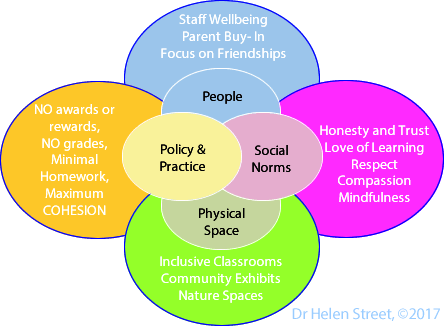 Contextual Wellbeing is a systems-based approach to supporting equitable education, youth wellbeing and self-determination in all schools and colleges through the development of a healthy school social context.
Contextual Wellbeing is a systems-based approach to supporting equitable education, youth wellbeing and self-determination in all schools and colleges through the development of a healthy school social context.
If we are to help young people to attain a love of learning, self-determination, and sustainable wellbeing, then we first need to understand what ‘wellbeing’ really is. We need to understand exactly what it is we are aiming to achieve. All too often we try to help a child who is distressed at school with strategies that are designed to help them to develop as a happier individual. For example, we try to teach them to be more confident, more resilient, or less anxious. But what if the answer was not wholly about trying to help that distressed individual make changes? What if the answer was more about creating a healthier context for that individual?
I believe that wellbeing is an interplay between our best individual selves and our best environment. As such, happiness and success are far more than individual pursuits, or even individual responsibilities. Rather, I believe that lasting happiness develops from the ongoing creation of healthy connections to others and the world around us. Happiness is a positive state of wellbeing resulting from our connection to a social context that supports and nurtures us so that we can become the best we can be.
As such, it is vital that we do not focus our definitions of wellbeing too narrowly on individual characteristics or strengths. All characteristics can relate to being well, if they are expressed appropriately, in the appropriate context. Ultimately, lasting wellbeing, and ultimate happiness are far less to do with any aspect of our individual functioning than we might like to think; and far more to do with our relationship with the context around us.
This expanded definition of wellbeing suggests that if we are truly to help young people, and indeed ourselves, to feel and live happily, we need to pay attention to the school social context in which they spend so much of their time. For example, rather than simply ‘teach’ growth mindset theory to children, we need to create a context in which value is placed more on the process of learning than on the outcomes. It is not enough to give overloaded staff stress management strategies, we need to support a working environment that enables them to survive and thrive. Instead of ‘telling’ students that they are all equally valued; we need to ‘show’ them they are all valued. Trophy cabinets depict hierarchies whereas group art projects depict community and creativity; honors boards depict the most valued students whereas pictures of whole school events depict the value of all students. People thrive in a healthy school social context but struggle in an unhealthy one, no matter how much ‘wellbeing & resiliency teaching’ they are given.
The Contextual Wellbeing model divides the school social context into four distinct domains: People (e.g. staff and students); physical space (e.g. classroom set-up, outdoor spaces); policies and practice (e.g. homework policy, behavioural management practices) and social norms (e.g. whether or not to trust others, how to treat others).
The majority of schools currently have a preponderance of inequitable practices, a lack of play and creativity and a competitive, outcome driven focus. This means that only a minority of students are learning in a context in which they can thrive.
The Contextual Wellbeing model is concerned with the development of a school social context which is equitable and supportive of ALL members of the school community and as such, enables everyone to flourish – academically, socially and emotionally, without the need for constantly gritted teeth or self-reflection.
The Contextual Wellbeing model is visually described below.
Schools can gradually and systematically develop wellbeing and equitable education across the entire school context with a focus on the development of each contextual domain.
Each domain of the model covers a key focus for positive contextual development:
People – e.g. school staff, students, parents and allied professionals. All members of a school community impact on the social context in terms of their values, attitude, skills and expressed behaviours. Attention paid to supporting autonomy, relatedness and competency can help all help members of the school community thrive (as per Deci and Ryan Self-Determination Theory). For example, socially competent staff with manageable levels of stress, and high levels of wellbeing have the skills and capacity to model positive behaviour to the entire class.
Physical Space – e.g. classroom and shared spaces, indoors and outdoors. The school physical environment is shaped by people and as such reflects the norms, values and ideals of the school community either openly or covertly. For example, a school reception that displays community photos gives out a very different message to one that displays trophies. In contrast, the power of nature to support student wellbeing and engagement in learning has been increasingly recognised.
Policy and Practice – e.g. the behavioural management policy, the use of rewards and awards, the homework policy. The policy and practices held by a school shape the level of equity within that school in addition to supporting either a focus on process or on outcomes. Policies and practices also dictate the importance placed on play and creativity, the value placed on competition and the need for control over cohesion and autonomy. For example, a school policy that does not include the use of rewards to motivate students is one that supports intrinsic motivation and equity far more than a policy that rewards the ‘top’ students and places everyone in a competitive hierarchy.
Social Norms – i.e. the unwritten rules that guide behaviour within the school community. Social norms stem from values and develop through repetition. Unhealthy social norms include locking bags and lockers as a sign of mistrust, talking in class and disrespecting teachers and seeing learning as a socially undesirable activity. In contrast, healthy social norms include being honest and trustworthy, being respectful to others and seeing learning engagement as a positive trait. Healthy social norms need to be actively and openly nurtured within the school community.
Contextual Wellbeing is not an add on program or activity. It is an ongoing process towards building a positive, equitable school community where everyone has the opportunity to flourish. To find out more about Contextual Wellbeing and the development of equitable and cohesive education within your own school, please visit Helen’s website www.contextualwellbeing.com.au or contact Helen directly on helen.street@uwa.edu.au or @drhelenstreet.
Helen will be conducting a full day pre-conference workshop at Positive Schools 2018 www.positiveschools.com.au



